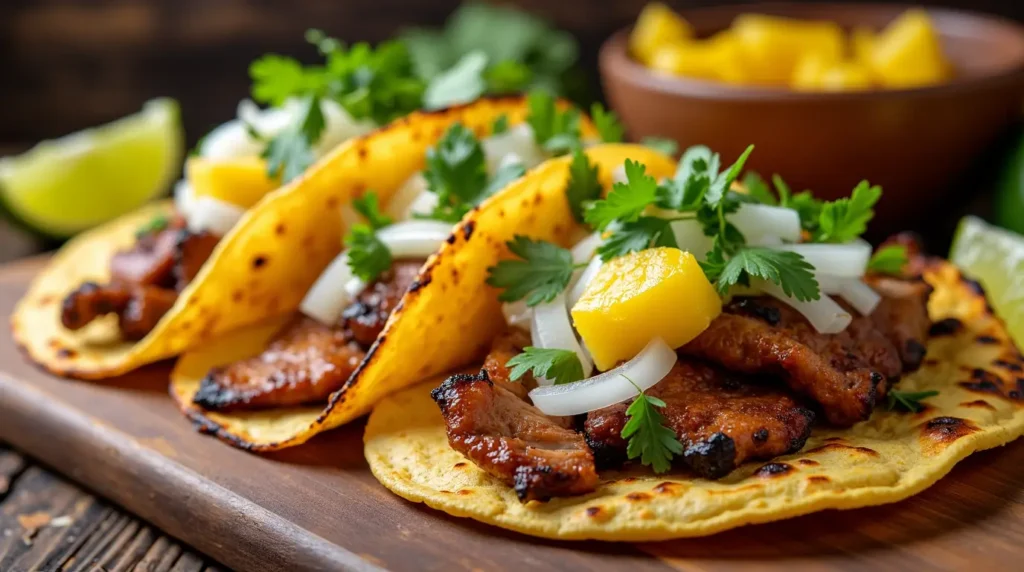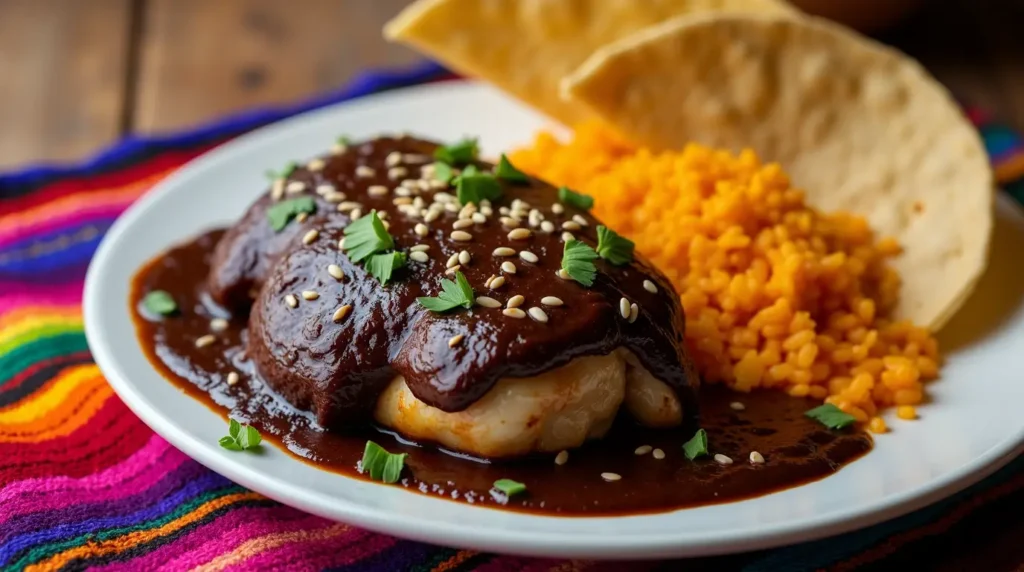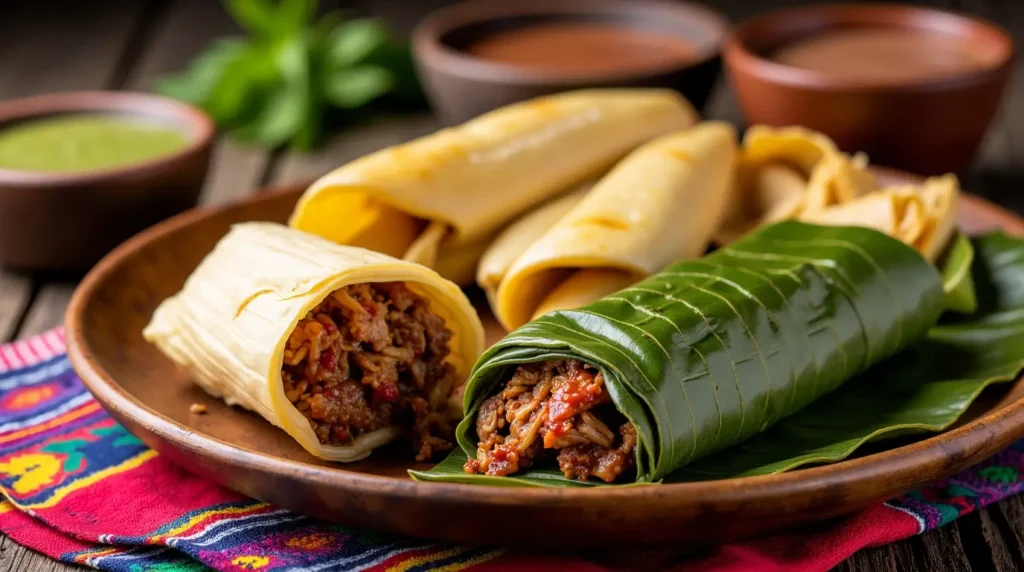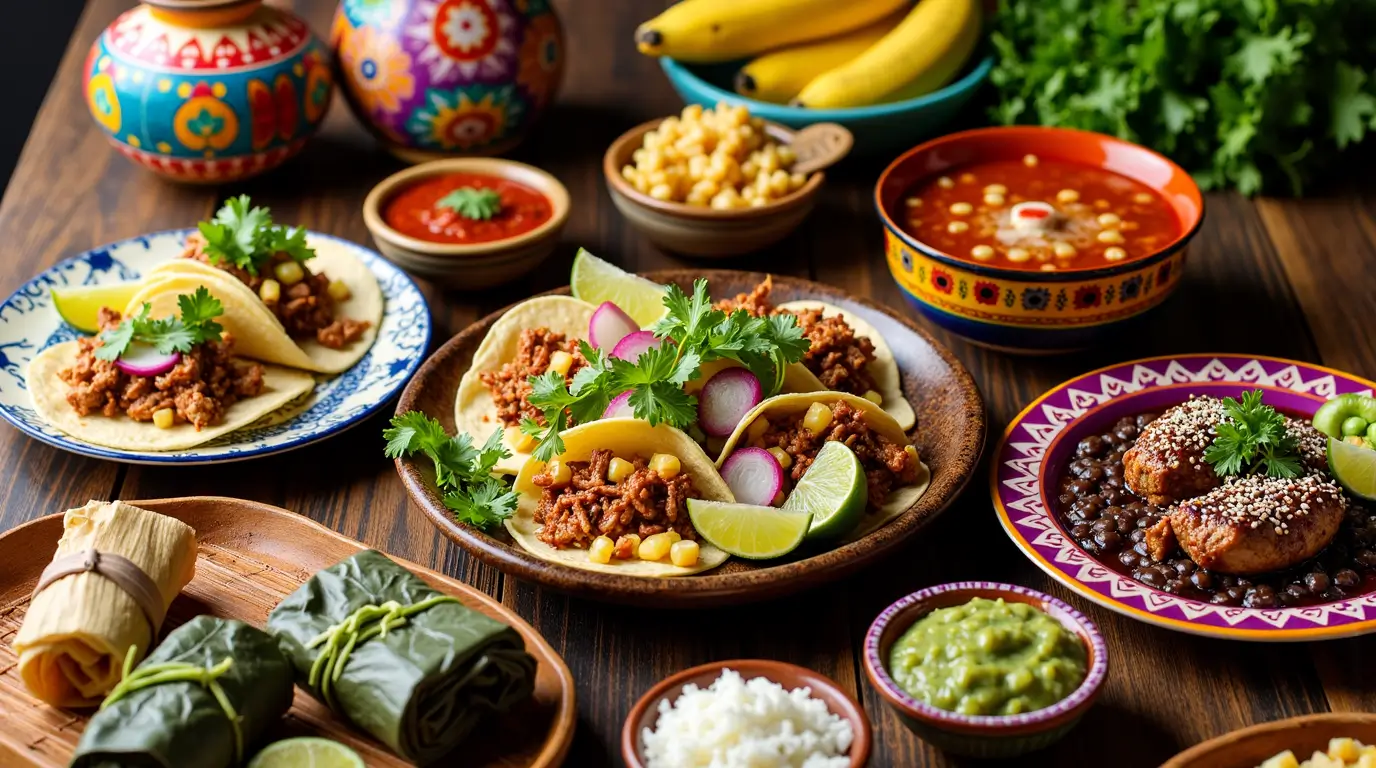Table of Contents
Introduction
Mexico’s cuisine is a treasure trove of bold flavors, colorful ingredients, and time-honored traditions. From its pre-Hispanic roots to its present-day culinary innovations, Mexican gastronomy is recognized worldwide for its complexity, variety, and cultural significance. It is far more than just tacos, enchiladas, and guacamole—though these staples certainly have a special place in people’s hearts. Mexican cooking reflects the interplay between indigenous heritage, Spanish colonial influences, and contemporary global trends. Every region, town, and family has its own cherished versions of classic dishes, giving Mexican cuisine an almost endless diversity.
The layers of flavors in Mexican cuisine often stem from a skillful use of chili peppers, herbs, and spices. Behind each dish stands a history of trade exchanges, migrations, and techniques passed down through generations. This article offers an in-depth look at the cuisine of Mexico, exploring its historical backdrop, key ingredients, distinctive regional variations, and modern transformations. By understanding these elements, you’ll be better equipped to appreciate the country’s iconic recipes, its signature culinary identity, and the warm spirit that ties it all together.
Whether you’re a food enthusiast, a curious traveler, or a home cook eager to try new dishes, the world of Mexican gastronomy is at once familiar and surprisingly vast. Join us on this journey through pre-Hispanic legacies, colonial influences, and modern fusions, as we uncover the reasons Mexican cuisine has been declared an “Intangible Cultural Heritage of Humanity” by UNESCO. Along the way, we will delve into must-try dishes, share practical tips for sourcing ingredients, explain table rituals and customs, and highlight the contemporary trends shaping this dynamic culinary scene.
Culinary Context and History Of Mexico’s cuisine
Pre-Hispanic Foundations
Mexico’s cuisine, rich culinary story begins long before the arrival of the Spanish in the early 16th century. For millennia, indigenous groups—such as the Aztecs, Mayans, and other Mesoamerican civilizations—cultivated a powerful culinary heritage that continues to influence Mexican cooking today. Corn (maize) sat at the center of these diets, serving not only as a staple food but also carrying spiritual significance. Beans, squash, tomatoes, cacao, and chili peppers were other cornerstones of pre-Hispanic cuisine, along with a wide array of local herbs and edible insects like grasshoppers (chapulines) and ant larvae (escamoles).
In many indigenous communities, the process of nixtamalization was—and still is—key: soaking dried corn in an alkaline solution of lime and water, which softens the kernels and increases nutritional value. This ancient technique remains essential for making tortillas, tamales, and other corn-based dishes throughout Mexico. Thanks to these enduring methods, the essence of pre-Hispanic cuisine persists, blending nourishment with cultural identity.
Spanish Colonization and Cultural Exchange
The Spanish conquest of Mexico in 1521 initiated a major shift in local gastronomy. While many indigenous staples remained, colonizers brought European ingredients such as wheat, rice, onions, garlic, certain spices, and domesticated animals like pigs, cows, and chickens. Over time, these new elements mingled with pre-existing foods, resulting in the layered, complex cuisine now associated with Mexico.
During the colonial era, the Catholic Church also played a significant role in culinary evolution. Monasteries and convents, staffed by nuns with access to both indigenous and European ingredients, created dishes that combined Mesoamerican techniques with European styles of cooking. Mole poblano, famously associated with the state of Puebla, is one example of this fusion—a rich, sauce-based dish featuring a ground mixture of spices, nuts, and chocolate combined with meats like turkey or chicken.
Post-Colonial Developments and Regional Influences
After independence in the 19th century, Mexico continued to see gastronomic exchanges, including those from France—leading to the popularity of pastries and certain European cooking methods. As Mexico’s trade routes grew, ingredients from other parts of the world, like Middle Eastern shawarma-style meats or East Asian spices, further diversified local cooking traditions. Today, many neighborhoods in major cities boast Lebanese-Mexican or Chinese-Mexican communities, whose culinary practices also contribute to the ever-evolving tapestry of Mexican gastronomy.
Through centuries of adaptation, each region of Mexico developed its own specialties and styles:
- Northern Mexico is characterized by its ranching culture, with a focus on grilled meats, beef-based stews, and flour tortillas (a result of Spanish wheat cultivation).
- Central Mexico—including Mexico City—draws from varied influences, featuring street foods like tacos al pastor (inspired by Middle Eastern shawarma) and an abundance of produce from surrounding states.
- Gulf Coast and Eastern Mexico highlight tropical flavors, featuring seafood, plantains, and citrus-infused dishes, reflecting both Afro-Caribbean and indigenous influences.
- Southern Mexico, especially Oaxaca and Chiapas, retains a strong indigenous presence and is known for complex moles, herb-based stews, and diverse use of local spices.
- Baja California in the northwest is recognized for its fresh seafood, wines from the Valle de Guadalupe, and a gastronomic scene shaped by proximity to the United States.
Such regional intricacies underline the importance of geography, climate, and cultural exchange. From arid desert areas in the north to lush rainforests in the south, Mexico’s varied landscape provides a canvas of ingredients and techniques, ensuring that no single dish can capture the country’s entire culinary identity.
Key Ingredients and Local Products
Emblematic Foods: Corn, Chiles, and More
When it comes to iconic Mexican ingredients, corn undoubtedly takes center stage. Masa (corn dough) is formed into tortillas, tamales, sopes, gorditas, and countless other staples. Beyond its adaptability, corn stands as a living symbol of Mexican identity, with traditions tied to sowing, harvesting, and ritual usage.
Another quintessential ingredient is the chile pepper—available in countless varieties, each offering distinct flavors and heat levels. From smoky chipotle to earthy ancho to fiery habanero, chiles are often dried, smoked, or pickled, increasing their culinary possibilities. These peppers can be used to flavor sauces, salsas, marinades, and stews, while also lending vibrant color.
The cuisine also makes heavy use of beans—pinto, black, or bayo—often cooked in clay pots for a rustic, hearty taste. Avocados, whether served simply sliced or mashed into guacamole, are another staple. Tomatoes, tomatillos, cilantro, epazote (an aromatic herb), onions, and garlic feature prominently in sauces and salsas. Meats include pork, chicken, beef, and goat, alongside fish and seafood in coastal areas.
Seasonality and Impact on Traditional Dishes
Mexico’s diverse climate allows for a year-round supply of fresh produce, yet seasonality still influences local dishes. During the rainy season, wild mushrooms (hongos) and certain edible plants become abundant, shaping traditional stews and soups. Around Day of the Dead (Día de Muertos) in early November, ingredients like cempasúchil flowers (Mexican marigolds) and seasonal fruits appear in markets, used for altars and certain ceremonial dishes. Similarly, tropical fruits like mango, papaya, and guava peak in specific months, inspiring fresh salsas and desserts.
Seasonal festivals also highlight beloved regional items, such as the huitlacoche (corn fungus) festival in certain states, which pays homage to this prized delicacy. Understanding the role of seasonality helps deepen one’s connection to Mexico’s gastronomic rhythms—foods are often at their tastiest when consumed at the peak of their harvest.
Tips on Purchasing Ingredients
For those seeking to recreate Mexican dishes abroad, locating authentic ingredients can feel like a treasure hunt, but it’s increasingly doable. Here are a few pointers:
- Local Markets: Latin American or Mexican grocery stores are the best starting point. Look for dried chiles in bags (like ancho, guajillo, pasilla), as well as masa harina (corn flour), achiote paste (especially if you want to try Yucatecan recipes), Mexican oregano, and epazote (fresh or dried).
- Online Specialty Stores: When physical stores are limited, numerous online retailers supply Mexican pantry staples—from dried beans and rice varieties to specialty chili pastes and fresh tortillas.
- Farmers’ Markets: Seasonal fruits and vegetables might include tomatillos, fresh chili peppers, squash blossoms, and certain herbs that can approximate Mexican flavors if epazote isn’t available.
- Substitutions: If you can’t find fresh epazote, a combination of cilantro and a pinch of oregano can lend some of its aroma. For rare chili peppers, try using widely available jalapeños or serranos for heat, and dried anchos or poblanos for earthiness.
By sourcing authentic products—or suitable substitutions—you can recreate many beloved Mexican recipes. While nothing beats the atmosphere of a bustling Mexican market, creatively adapting ingredients can still bring that special zest to your home kitchen.
Must-Try Traditional Dishes in Mexico’s cuisine
Mexico’s traditional dishes are as varied as its landscapes. Below are a few emblematic preparations you should taste or attempt to cook at least once.
Tacos al Pastor

Origins and Characteristics
A quintessential street food particularly famous in Mexico City, tacos al pastor owe their roots to Middle Eastern immigrants who introduced shawarma-style cooking to Mexico. Marinated pork is layered on a vertical spit (called a trompo), roasted, then thinly shaved onto small corn tortillas. A slice of pineapple, onion, cilantro, and a squeeze of lime typically finish this savory-sweet combination.
Regional Variations
Variations can include “gringa” style—a taco made with a flour tortilla and melted cheese—or “tacos árabes” in Puebla, using a Middle Eastern-style bread instead of tortillas.
Tips for Making at Home
- Marinade: A blend of achiote paste, chili peppers, pineapple juice, and spices (like cumin and oregano) is used to coat thin slices of pork.
- Cooking Method: While a vertical spit might not be practical at home, you can grill or bake the marinated meat and then slice it.
- Serving: Warm up small corn tortillas, top with the sliced meat, cilantro, onions, pineapple chunks, and salsa of your choice.
Mole Poblano

History and Characteristics
Mole poblano, often cited as the national dish of Mexico, showcases the synergy between indigenous and colonial flavors. Legend has it that nuns in a Puebla convent created the dish to impress a visiting archbishop, hastily combining available ingredients—chili peppers, nuts, spices, and a bit of chocolate. The result was an intricate, velvety sauce typically served over turkey or chicken.
Regional Variations
While mole poblano is perhaps the most famous, Mexico boasts many mole types: mole negro, mole coloradito, mole amarillo, and more, particularly in the state of Oaxaca, which is often called the “Land of the Seven Moles.” Each variation uses unique chili blends and thickening agents (like ground tortillas, nuts, or seeds).
Simplified Recipe
- Toast and Soak Chiles: Use a combination of dried ancho, pasilla, and mulato chiles. Remove seeds, toast them lightly, then soak in warm water until softened.
- Blend: Puree the chiles with toasted almonds, pumpkin seeds, onions, garlic, cinnamon, and a piece of Mexican chocolate (or a bit of unsweetened cocoa powder with sugar).
- Simmer: In a pot, sauté this blended mixture in a bit of oil, add chicken stock, and stir until the sauce thickens. Adjust seasoning (salt, sugar) to balance sweetness and spice.
- Serve: Pour over cooked chicken or turkey and garnish with sesame seeds.
Pozole

Origins and Characteristics
Pozole is a hearty soup or stew based on hominy (nixtamalized corn kernels) and meat (commonly pork or chicken). It is associated with ceremonial significance in pre-Hispanic times. Today, pozole is often served during celebrations, such as Mexican Independence Day, and topped with lettuce, radishes, onions, lime juice, and chili pepper.
Regional Variations
- Pozole Rojo: Made with red chilies, typical of Jalisco.
- Pozole Verde: Common in Guerrero, featuring green ingredients like tomatillos, cilantro, and pepitas (pumpkin seeds).
- Pozole Blanco: A simpler version with a clear broth.
Tamales

Origins and Characteristics
Tamales date back to Mesoamerican civilizations, who prepared them as portable meals for warriors or travelers. They consist of masa (corn dough) filled with meats, cheese, vegetables, or sweet mixtures, wrapped in corn husks or banana leaves, and steamed. Tamales hold a place of honor during festivities like Candlemas (Día de la Candelaria) and Christmas.
Flavor Variations
- Oaxacan Tamales: Often wrapped in banana leaves, featuring mole or black bean fillings.
- Sweet Tamales: Colored pink and filled with raisins, pineapple, or other fruits.
- Regional Fillings: Rajas (strips of poblano peppers) with cheese, pork in red chile sauce, and chicken with green salsa.
Defining Characteristics of Mexican Cuisine
Spice and Flavor
Mexican cuisine is famed for its bold, spicy edge—though not all dishes are hot. The use of chiles spans the spectrum from mild to fiery, so you can typically adjust the spiciness to suit your palate. Salsas, made fresh or cooked, are a fundamental part of the table, offering various heat levels and flavor undertones (smoky, tangy, sweet, or herbal).
Complex Sauces and Seasonings
Complex sauces like moles, pipián (pumpkin seed sauce), and adobos rely on layered chili pepper blends, nuts, seeds, and spices. This emphasis on harmonious combinations of sweet, savory, and earthy elements distinguishes Mexican cooking from many other global cuisines.
Appeal for Food Enthusiasts
Food lovers seeking intense flavors will delight in the interplay of chili peppers, herbs, and indigenous techniques. There’s also a sense of adventure in discovering the wide variety of chiles—each with unique flavor profiles—and in sampling lesser-known dishes like chapulines (seasoned grasshoppers) or tlayudas (large toasted tortillas topped with beans, cheese, and meat). Such experiences underscore the depth and diversity of Mexican culinary traditions.
Tips and Highlights to Encourage People to Try Mexican Cuisine
Anecdotes and Cultural Richness
Mexican cuisine is deeply intertwined with family gatherings, religious celebrations, and street food culture. Sit down to a plate of tacos al pastor in Mexico City, and you’ll likely find families, office workers, and travelers all sharing a communal space. The sizzle of meat on the grill, the smell of fresh tortillas, and the vibrant colors of salsas awaken your senses.
Local Markets as a Microcosm
A trip to a traditional market (mercado) is a treat in itself—vendors offering fresh produce, homemade tortillas, locally made cheeses, and spiced candy. There is an unspoken tradition of tasting ingredients as you shop, forging a deep connection to the food you later eat.
Sense of Discovery
For those tired of routine meals, Mexican cuisine provides a gateway to new textures and flavors. Adventurous eaters can sample ceviche infused with tropical fruits, or treat themselves to a classic street snack like esquites (corn kernels sautéed in butter and topped with mayo, cheese, and chili powder). Even something as common as a simple street quesadilla in Mexico might contain squash blossoms or huitlacoche, showcasing how ordinary staples can be elevated with local treasures.
Table Rituals and Customs
Daily Meal Structure
- Breakfast (Desayuno): Might include huevos rancheros (eggs in a chile-tomato sauce), chilaquiles (tortilla chips simmered in salsa), or pan dulce (sweet bread) with coffee.
- Lunch (Comida): Traditionally the largest meal of the day, often starting with soup, followed by a main course (guisado) and possibly a small dessert.
- Dinner (Cena): Generally lighter, perhaps a bowl of soup, tacos, or leftovers from the main midday meal.
- Merienda: An afternoon snack—could be sweet bread and hot chocolate, especially common in cooler regions or after a long day.
Etiquette and Customs
- Sharing Food: Offering a taste of your meal is common courtesy, reflecting hospitality and familial warmth.
- Handheld Foods: Tacos, tlacoyos, and sopes are often eaten with the hands, but there’s a small technique involved in folding or tilting them so they don’t fall apart.
- Refusing Food: Persistently declining food might be seen as slightly rude or a sign you’re not enjoying the host’s hospitality, although people are generally understanding.
- Toasting: Saying “¡Salud!” (which literally means “Health!”) is the standard for raising glasses. If you’re enjoying tequila or mezcal, be sure to sip rather than knock it back in one go, showing appreciation for its craftsmanship.
Festivities and Special Occasions
- Day of the Dead (Día de Muertos): Typically celebrated on November 1st and 2nd, families prepare pan de muerto (a sweet, anise-flavored bread) and other favorites of departed loved ones to place on altars.
- Christmas and Posadas: Tamales, buñuelos (fried dough pastries), and ponche (a hot fruit punch) are common.
- Dia de la Candelaria (Candlemas): Tamales again play a big role—those who find the miniature figurine in the Rosca de Reyes (King’s Cake) served on Epiphany have the responsibility of hosting a tamale feast on February 2nd.
- National Holidays: Pozole is almost synonymous with Mexican Independence Day (September 15th–16th), when families and friends gather to celebrate with a hearty stew, music, and fireworks.
Modern Trends and Culinary Fusions
Global Influence and Fusion Cuisine
In big cities like Mexico City, Guadalajara, and Monterrey, high-end restaurants and street stalls alike experiment with novel combinations. Culinary innovations might see Japanese-inspired tacos filled with tempura shrimp and served with a soy-based salsa, or it might involve combining Italian pasta with classic Mexican sauces—think mole or poblano cream sauce over spaghetti. These hybrid dishes underscore the fact that Mexican cuisine continues to evolve, ever open to external influences while retaining its unique identity.
New Consumption Trends
- Vegetarian and Vegan Cuisine: With a growing global shift toward plant-based diets, Mexican chefs are revisiting classic recipes—like tacos de hongos (mushroom tacos) or jackfruit carnitas—to cater to vegetarian and vegan palates.
- Farm-to-Table and Organic Food: The farm-to-table movement has found a natural fit in Mexico, where local markets and small-scale farms have historically supplied fresh produce. Modern chefs are placing renewed emphasis on sustainability, terroir, and seasonal specialties.
- Artisanal Mezcal and Craft Beers: Another noticeable trend is the rise of artisanal mezcal distilleries and craft breweries, harnessing indigenous agave varieties and native grains, respectively, to craft beverages that pair elegantly with Mexican cuisine.
Young Chefs and Contemporary Interpretations
A new generation of Mexican chefs is achieving international recognition. In major cities and tourist hubs, you’ll find tasting menus that deconstruct traditional dishes, presenting them in avant-garde ways. For instance, a chef might reinterpret a classic pozole by turning the hominy into a foam or featuring miniature stuffed corn cakes on the side, playing with form and presentation while preserving the essence of the dish.
Such endeavors help elevate Mexican cuisine on the global stage, demonstrating that it can be both authentically historical and excitingly modern. With each chef adding personal flair, the gastronomic possibilities continue to expand, ensuring that Mexico’s culinary traditions remain vibrant and relevant for future generations.
Conclusion and Call to Action
From its ancient Mesoamerican origins to its modern-day fusion experiments, Mexican cuisine stands out for its dynamism, diversity, and profound cultural resonance. The importance of corn, beans, chili peppers, and a rich variety of spices is woven into the social fabric, reflecting a long history of adaptation and innovation. Beyond the bold flavors and colorful presentations, Mexican gastronomy is deeply tied to tradition, celebration, and a sense of communal warmth at the table.
We’ve traced the regional distinctions—from the grilled meat culture of the north to the complex moles of the south—and explored emblematic dishes like tacos al pastor, mole poblano, pozole, and tamales. Each dish serves as a window into Mexico’s cultural tapestry, revealing layers of indigenous legacies, Spanish colonial influences, and international exchanges. Whether you’re interested in a spicy salsa, a sweet tamale, or a tangy ceviche, you’ll discover endless possibilities for exploration.
If you’re tempted to take a deeper dive, start by sourcing key ingredients like dried chili peppers, masa harina, and fresh produce from local or online specialty stores. Experiment with marinade recipes, try making homemade tortillas, and don’t be shy about adjusting the spice level to your liking. Be sure to approach these dishes with an open mind and a readiness to embrace Mexico’s vibrant tapestry of flavors.
We’d love to hear from you: Which Mexican dishes have you tried, and what’s on your to-cook list? Have you discovered an unforgettable street food stand or a special holiday tradition you’d like to share? Drop your stories, recipes, or questions in the comments, and let’s keep the conversation going about this ever-fascinating cuisine.
Looking ahead, we might explore in a future article the role of Mexican sweets and desserts—like churros, tres leches cake, and sugar skulls—in shaping the country’s culinary identity. Until then, may your kitchen (or restaurant visit) be filled with the comforting aromas of Mexico’s finest dishes, and may each bite bring you closer to understanding the passion and heritage that make Mexican gastronomy so beloved worldwide.
¡Buen provecho!

